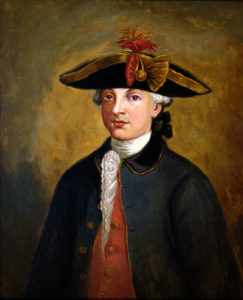Esteban Rodriguez Miro y Sabater
Serving from 1782 until 1791, Spanish-colonial governor Esteban Miró oversaw a period of relative economic prosperity.

Courtesy of Louisiana State Museum
Esteban Miró. Molinary, Andres (Artist)
Serving from 1782 until 1791, Spanish colonial governor Esteban Miró oversaw a period of relative economic prosperity in the Louisiana territory. During his term, he encouraged colonists to be inoculated against smallpox and advocated crop diversification, especially after the royal tobacco monopoly stopped buying the crop in Louisiana. After a devastating fire nearly destroyed New Orleans in 1788, Miró oversaw the city’s efforts to rebuild. On orders from Spain, he also worked to discourage US settlers from occupying the land they were awarded in the Treaty of Paris (1763).
Esteban Rodríguez Miró y Sabater was born in Catalonia, Spain, in 1744 to Francisco Miró and Marian de Miró y Sabater. Little is known about his early life or education, though his service in the Spanish military is documented. A cadet in 1760, he fought in the Portuguese campaign of 1762. From 1767 to 1773 he served in the First Battalion of the Fixed Infantry Regiment of the Crown of New Spain, before rising to the rank of adjutant major in the Lisbon Infantry Regiment, where he remained until 1777. In the fall of 1778 he was appointed lieutenant colonel of the Louisiana Regiment. The next year, he married Céleste Eléonore Elisabeth Macarty of New Orleans, deepening his ties to the region.
From 1780 to 1781, Miró served as aide-de-camp to then-governor Bernardo de Gálvez, raising troops in Havana for the successful Mobile campaign of 1780 in support of the American Revolution against Britain. Miró also helped organize the suppression of the Natchez Rebellion in 1781 and, later that year, was promoted to the rank of colonel and commander of the Louisiana Regiment. When Gálvez traveled to Cuba between 1782 and 1785, Miró served as interim governor of Louisiana, leading to his appointment as governor in 1785. On May 10, 1788, he assumed the duties of intendant as well as governor.
During his term, the Spanish Crown ordered Miró to prevent US settlers from occupying Spanish property. To accomplish this task, he conspired with American soldier and statesman James Wilkinson and others to try to detach land—now part of Kentucky—from the United States in the hopes of building a separate Spanish nation. Miró also worked to prevent US land companies from occupying parts of what is now Mississippi. After the Great Fire of 1788 destroyed much of New Orleans, his administration oversaw the construction of public buildings.
Miró relinquished his office to the Barón de Carondelet in 1791. He was promoted to brigadier general in 1793 and fought in the war against the First French Republic (1793–1795). He died in the Pyrenees Mountains on June 4, 1795.
Adapted from Paul E. Hoffman’s entry for the Dictionary of Louisiana Biography, a publication of the Louisiana Historical Association in cooperation with the Center for Louisiana Studies at the University of Louisiana, Lafayette.
Sources: Jack D. L. Holmes, “Introduction,” to document one, Documentos ineditos para la historia de Luisiana, 1792-1810 (1963); Caroline M. Burson, The Stewardship of Don Esteban Miro, 1782-1792 (1940); Arthur P. Whitaker, “Miro, Esteban Rodriguez, 1744-1795,” Dictionary of American Biography (1928-58).
